An exciting new Warlock archetype has emerged from the ashes of the recent nerfs, one that might seem quite familiar to those of us who have played Hearthstone in its early days. Two Mountain Giants early on as pressure, plus two Twilight Drakes for consistency? Sounds like Handlock to me… but what is this one-mana Life Tap thing? There are quite a few similarities – and also some very illuminating differences – between the two, and there are some interesting lessons to consider from that old-school control deck when you’re trying to pilot this shiny new one to Legend.
Tapping Up
So we’ve got two decks with a plethora of premium AoE options that tap a lot at the start of the so that they can beat you down with early Mountain Giants, then juggle with their health total to play overstatted minions before healing back, eventually going for a high-value finisher hero card that outpaces every other opponent in the late-game. Their general strategy and core cards are very similar, and it is very interesting to see such a deck again in Standard considering how Handlock just disappeared with the now-reverted nerf of Molten Giant just before the introduction of Standard.
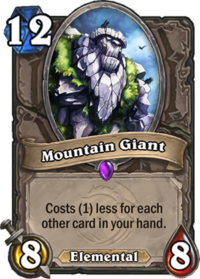
While it might seem logical because of the similar deckbuilding restriction, it wouldn’t actually be that helpful to compare this deck with Renolock: as much as I loved to get rich over and over again, its anti-aggro strategy basically was “draw Mountain Giant, or if that doesn’t go off, a Twilight Drake at least. Even Warlock’s cheaper ability allows you to play the 8/8 as early as turn 3 provided you have the Coin in hand – and while that’s certainly a flashy option, the real strength of the upgraded hero power is its extreme flexibility. The original Handlock decks sometimes struggled in the mid-game to make use of their innate card draw ability simply because many of their cards are too clunky or expensive to simply just toss them out: you’d have to play two and still have two mana crystals left to be able to continue the cycling you’ve began in the early turns.
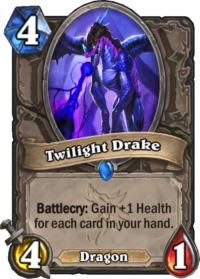
Even Warlock is able to start this process earlier and needs a lot less leeway to set up a re-tap to nine cards. It’s always been true that you should try to tap as often as possible even in the slower matchups since you’ll be able to change your hero power later on in the game into something that will very much make up for the difference in the fatigue clock – this is something the modern iteration makes a lot easier to accomplish.
Of course, the constant tapping isn’t really an option when you’re up against an aggressive opponent, and those were generally the bane of Handlock’s existence: that deck would have killed for a card like Defile as its earliest board clear option – apart from a Ironbeak Owls – was a 4-cost Hellfire, which has both caused self-damage and gained no initiative. Its premium healing source was the lowly Earthen Ring Farseer in the Classic days, though the situation has become a lot better once Antique Healbot showed up in GvG alongside Naxx’s excellent Sludge Belcher as a sticky taunt.
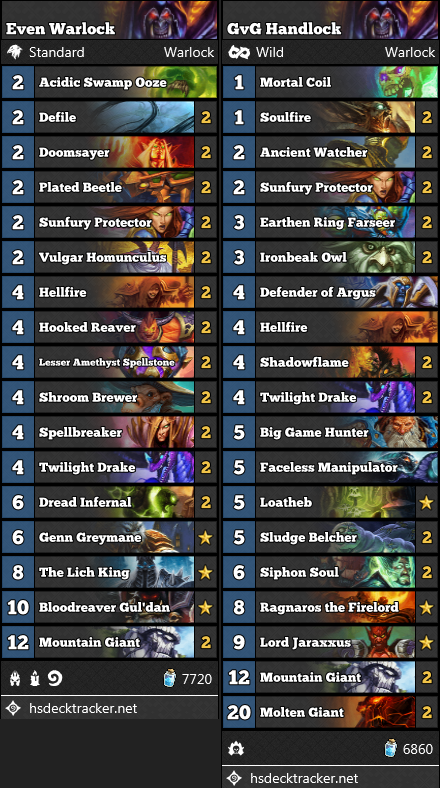
Before that, generally, one you went low, there was no going back – and this is where the Molten Giants come in, ready to punish the aggressor who puts you on the ropes without being able to finish you off. Having only four health against a minion-based deck is absolutely fine once you can play two 0 mana 8/8s out of nowhere with the ability to taunt them up. This was the anti-aggro plan: giant taunts and a cracking backswing – if not with the Moltens, then their mentally damaged little brothers, the Ancient Watchers had to do the trick.. Even Warlock has a much easier time in that regard as well.
A Fight for Survival
The smart manipulation of health and hand size is extremely important for both decks, but Even Warlock certainly has an easier time if it wants to keep its life total in a reasonable range. The stronger AoE options and the better healing cards. Shroom Brewer and Plated Beetle are really nothing special, but the real stars of the show are the Spellstones and their synergistic nature with the self-damaging cards, many of which are Demons that eventually return to the fray with Bloodreaver Gul'dan.
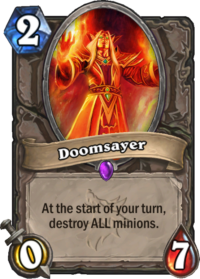
There’s also a very interesting alternative to the blade dance revolving around Molten Giants: Hooked Reavers are a huge taunt on their own, provided you’re below 15 health, which was around the threshold where the 8/8s were originally playable as well. Again, they also have some Demon synergy, which was not at all present in the original Handlock builds – simply because it wasn’t a part of the game at that point.
Still, the general idea is the same again: don’t be afraid to go low against slower decks as your advantage comes from the extra cards in hand and the big minions on board, both requiring a ton of Life Taps. Since you have a very limited capacity to generate additional value, such tempo considerations are very important. Health is secondary to value when you’re not getting your face bashed in – and against fellow control players, your swathe of 8/8s and 7/7s will likely spare you from that fate as long as you’re willing to go deep to find them.
The End Game
Lord Jaraxxus was really the original Death Knight – and it makes sense that he has been completely superseded by Bloodreaver Gul’dan for a multitude of reasons. Still, the Eredar Lord of the Burning Legion has fulfilled the same role as everyone’s favorite lifestealer does, with quite a few extra caveats: his health is capped at 15, making it challenging to find the right spot to play him without dying, and even harder to avoid death by burst during the subsequent turns.
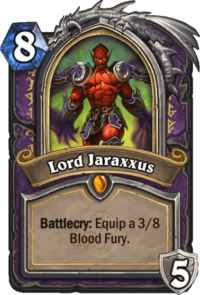
On the other hand, the Death Knight instantly generates a board for you in most cases – giving your deck a Demon synergy element as well –, guarantees 5 health gain on the turn you play it and will keep healing you for the rest of the game. It is almost a clear-cut upgrade over Lord J, even if there are a few match-ups today – like Odd Warrior and Big Spell Mage, for instance – where you would often be better off with the demon lord’s hero power as opposed to Siphon Life.
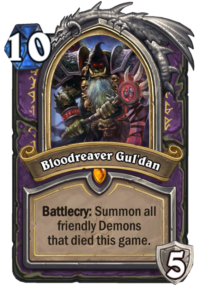
Both cards are the lynchpins of your anti-control strategies and both require some planning and set-up to get the most value out of them, even if it’s for very different reasons. You want to get them out as fast as possible: in a slow match-up, your original hero power eventually runs out of use, especially when it is discounted. These are the cards that allow you to keep up with the decks that can deal with your undercosted 8/8s – and can single-handedly win you the game in the process. If you’re sure that your opponent is playing a control deck, there’s a good argument to outright keep them in your opening hand.
All in all, Even Warlock and Handlock are surprisingly similar decks, not just on the archetypal level, but in direct playstyle – so if you can dust off the old strategy guides and recall some of those experiences where 2 mana 6/6 Infernals were the ultimate late-game value generation, you should be able to gain some additional wins during your climb.

It’s sad to see Evenlock getting so much hype. It was a great deck before (had a 59% winrate from rank 5-1) even though it was 20-80 against every other Warlock deck. And it was below 5% of the meta.
Now that 2 streamers played it too, it’s the new go-to netdeck. Funfact: In the early meta it had a better matchup against Evenpala than against Odd.
I love playing fringe decks, now I have to play something else. RIP beloved Evenlock – you will be encountered often and missed nontheless.
I think the nerf to Cube Lock (long awaited and requested by most of the HS community) played a big part on spreading Even Lock. It was the most logical deck to go to. Either way, except for loosing the surprise factor, I fail to see how a deck becoming mainstream is a bad thing for such deck. And its not like Even Lock is tricky combo deck that can be countered easely if your opponent knows what you’re up to, like some off-meta decks. You basically give away your strategy as soon as Genn shows up before the game starts.
I miss the Lord Jaraxxus 🙁 … It used to be so satisfying to play…
I really love this deck! I love to play early giants and I’m really enjoying Hooked Reaver, in the right contest is a strong card.
Is anybody in the making of a non-even handlock? I’ve tried building the deck, but the only benefits I can see from odd cards are faceless, godfrey, coil, kobold librarian, chittering tunneler, tar creeper, and rotten applebaum. Coil and faceless are really good, but only chittering tunnler (for the flexibility and spellstone and reaver synergy) and applebaum seem decent from testing.
Been trying since Witchwood started. Unfortunately it is just not worth it. Even version will be stronger cause of 1 mana hero power, it makes a huge difference.
Another note: Ironbeak Owl used to cost 2 mana back then.
Yet another note – in pre-GvG lists, Soulfire used to cost 0 mana 🙂
Should be game not “Eame” in the last section